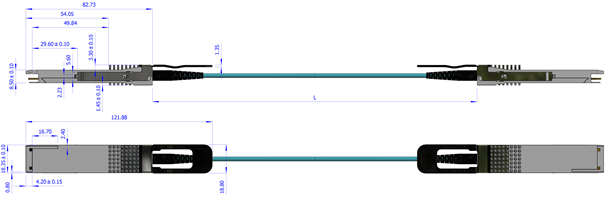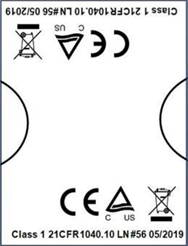Specifications
Absolute maximum ratings are those beyond which damage to the device may occur.
Prolonged operation between the operational specifications and absolute maximum ratings is not intended and may cause permanent device degradation.
Absolute Maximum Ratings
|
Parameter |
Min |
Max |
Units |
|
Supply voltage |
-0.3 |
3.6 |
V |
|
Data input voltage |
-0.3 |
3.465 |
V |
|
Control input voltage |
-0.3 |
4.0 |
V |
|
Damage Threshold |
3.4 |
--- |
dBm |
This table shows the environmental specifications for the product.
|
Parameter |
Min |
Max |
Units |
|
Storage temperature |
-40 |
85 |
°C |
This section shows the range of values for normal operation. The host board power supply filtering should be designed as recommended in the SFF Committee Spec.
|
Parameter |
Min |
Typ |
Max |
Units |
|
Supply voltage (Vcc) |
3.135 |
3.3 |
3.465 |
V |
|
Power consumption (each end, retiming on all lanes) |
--- |
4.8 |
5.0 |
W |
|
Power dissipation (each end, HDR100, 2 lanes on) |
--- |
2.9 |
3.1 |
W |
|
Supply noise tolerance (10Hz – 10MHz) |
66 |
--- |
--- |
mVpp |
|
Operating case temperature |
0 |
--- |
70 1 |
°C |
|
Operating relative humidity |
5 |
--- |
85 |
% |
|
Latency2 |
--- |
20 + 5 x L |
--- |
ns |
Internal temperature readout through DDMI of up to 75°C is allowed.
Informative, L = cable length in meters.
Table 5: Electrical Module Specifications
|
Parameter (per lane) |
Min |
Typ |
Max |
Units |
|
Signaling rate |
-100 ppm |
53.125 |
+100 ppm |
GBd |
|
Differential data input swing at TP1a |
TBD |
--- |
900 |
mVpp |
|
Differential data output swing at TP4 |
--- |
--- |
900 |
mVpp |
|
Near-end ESMW |
0.265 |
--- |
--- |
UI |
|
Near-end output eye height |
70 |
--- |
--- |
mVpp |
|
Output transition time, 20% to 80% |
9.5 |
--- |
--- |
ps |
Notes:
Multiple clock domains are supported only on the line-side Rx. Host side Rx supports a single clock domain only.
QSFP Tx CDR lock can only occur if Tx lane 4 is transmitting data.
This product is compatible with ESD levels in typical data center operating environments and certified in accordance with the standards listed in the Regulatory Compliance Section. The product is shipped with protective caps on all connectors to protect it during shipping. In normal handling and operation of high-speed cables and optical transceivers, ESD is of concern during insertion into the OSFP cage of the server/switch. Hence, standard ESD handling precautions must be observed. These include use of grounded wrist/shoe straps and ESD floor wherever a cable/transceiver is extracted/inserted. Electrostatic discharges to the exterior of the host equipment chassis after installation are subject to system level ESD requirements.
For configurations tested with the AOCs please refer to the system level product (SLP) qualification report.
The AOC supports rate select, which is controlled by writing to registers 0x57-0x58. Two bits are assigned for each receiver lane in byte 0x57 (87dec, Rxn_Rate_Select) and two bits for each transmitter lane in byte 0x58 (88dec, Txn_Rate_Select) to specify up to four bitrates, as defined in SFF-8636 Rev 2.9.2 Table 6-5 XN_RATE_SELECT ENCODINGS. All four lanes are required to have the same rate select value.
The below table specifies the rate for each rate select setting.
Rate Select Encodings
|
Rate Select Value |
Operating Rate (GBd) |
|
10 |
25.78125 NRZ (EDR) |
|
11 |
26.56250 PAM4 (HDR) |
|
Parameter |
Value |
Units |
|
|
Diameter |
3 +/-0.2 |
mm |
|
|
Minimum bend radius |
30 |
mm |
|
|
Length tolerance |
length < 5 m |
+300 /-0 |
mm |
|
5 m ≤ length < 30 m |
+500 / -0 |
||
|
Cable color |
Aqua |
--- |
|
Mechanical Dimensions

Cable Length Definition

The following label is applied on the cable’s backshell:
Backshell Label

(sample illustration)
Backshell Label Legend
|
Symbol |
Meaning |
Notes |
|
SN – Serial Number |
||
|
MT |
Manufacturer name |
2 characters MT |
|
YY |
Year of manufacturing |
2 digits |
|
WW |
Week of manufacturing |
2 digits |
|
XX |
Manufacturer site |
2 characters |
|
SSSSS |
Serial number |
5 digits for serial number, starting from 00001. Reset at start of week to 00001. |
|
Miscellaneous |
||
|
ZZ |
HW and SW revision |
2 alpha-numeric characters |
|
YYYY |
Year of manufacturing |
4 digits |
|
MM |
Month of manufacturing |
2 digits |
|
DD |
Day of manufacturing |
2 digits |
|
COO |
Country of origin |
E.g. China or Malaysia |
|
|
Quick response code |
Serial number (MTYYWWXXSSSSS) |
The following label is applied on the cable’s jacket:
Fiber Cable Jacket Labels


(sample illustration)
Note: The serial number and barcode are for NVIDIA internal use only. Different layouts of this label apply to different production series. It has no effect on the cable's performance nor function.
The laser module is classified as class I according to IEC 60825-1, IEC 60825-2 and 21 CFR 1040 (CDRH).
Safety: CB, cTUVus, CE
EMC: CE, FCC, ICES, RCM, VCCI
Ask your NVIDIA FAE for a zip file of the certifications for this product.
Each of the devices complies with CFR47 FCC Class A Part 15 of the FCC Rules. Operation is subject to the following two conditions:
This device may not cause harmful interference.
This device must accept any interference received, including interference that may cause undesired operation.
Note: This equipment has been tested and found to comply with the limits for a Class A digital device, pursuant to Part 15 of the FCC Rules. These limits are designed to provide reasonable protection against harmful interference in a residential installation. This equipment generates, uses and can radiate radio frequency energy and, if not installed and used in accordance with the instructions, may cause harmful interference to radio communications. However, there is no guarantee that interference will not occur during installation. If this equipment does cause harmful interference to radio or television reception, which can be determined by turning the equipment off and on, the user is encouraged to try to correct the interference by one or more of the following measures:
Reorient or relocate the receiving antenna.
Increase the separation between the equipment and receiver.
Connect the equipment into an outlet on a circuit different from that to which the receiver is connected.
Consult the dealer or an experienced radio/television technician for help.
Modifications: Any modifications made to this device that are not approved by NVIDIA may void the authority granted to the user by the FCC to operate this equipment.

